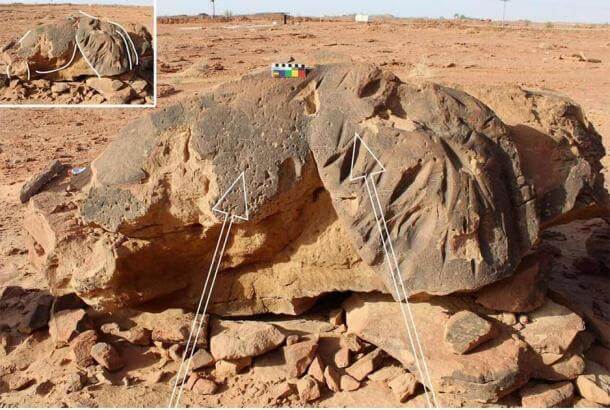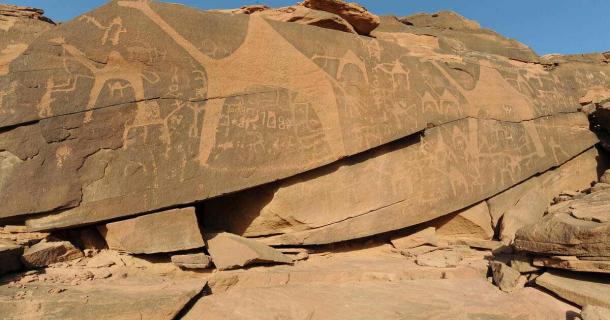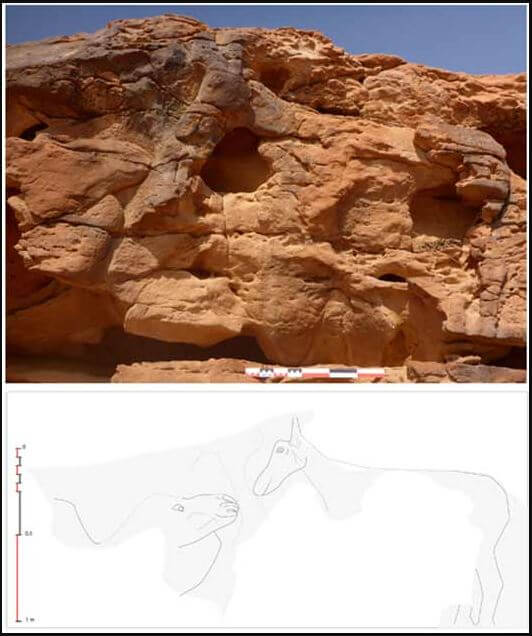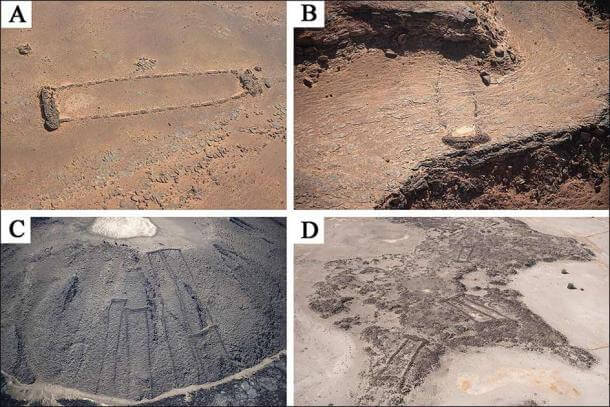
Giant incredibly old engravings of camels in the Saudi desert
 22. 11. 2021
22. 11. 2021

A team of archaeologists examining life-size rock carvings in the Saudi desert has been shocked to find out the true age of these impressive stone sculptures. These carved figures of giant camels were first discovered in 2018, and were originally estimated to be about 2 years old. However, the new analysis used more advanced dating methodologies and revealed that these remarkable reliefs were in fact created 000 to 7 years ago, which forced a fundamental reassessment of their significance and importance.
These are the oldest three-dimensional rock sculptures of animals in the world, which precede the pyramids at Giza and the English Stonehenge by several thousand years.

The camel site may have held regular gatherings organized by scattered hunting and herding people. (M. Guagnin & G. Charloux / Journal of Archaeological Science: Reports)
Camel statues, Neolithic gatherings, fertility rituals
Saudi Arabia, with more than 1 rock art sites, some dating back to 500 years ago, has become a popular destination for archaeologists seeking to gain insights into the art of making the art.
Archaeologists involved in researching the Camel Site in the northwestern province of Al Jawf in Saudi Arabia have worked with the Saudi Ministry of Culture, the Max Planck Institute for Human History Research, the French National Center for Scientific Research and King Saud University in Riyadh.
At the beginning of the research, they assumed that the animal reliefs were carved in stone at the end of the 1st century BC or the beginning of the 1st century AD. near the Jordanian city of Petra.
However, a closer examination of the typical features of the engravings showed that the reliefs were carved with stone rather than metal tools (which corresponds to Neolithic dating instead of a previous estimate from the end of the Iron Age). Weathering and erosion also correspond to an earlier than estimated time classification, and geological research of the upper layers of the rock has also helped reveal the true age of the camel sculptures.
Realistic figures
Archaeologists at the site have identified a total of 21 carved three-dimensional reliefs. Most of them were camels, but horses and horse-like animals were also represented. Remarkable sculptures were carved into the three rocky promontories, and their creators certainly had to use scaffolding to get to the upper parts of these promontories at all.
The characters they created were very realistic, and from the grounder's point of view, the animals seemed to emerge from the rock, as if ready to come to life and enter the real world.
- Camel rock art at Shuwaymis East in Saudi Arabia. (Arabian Rock Heritage)
- Rock relief depicting a reclining dromedary raising its head towards an equine animal, probably a donkey or mule. (CNRS / MADAJ, G. Charloux / Antiquity)
"They're absolutely stunning, and when we realize that we now see them in a heavily eroded state with many fallen pieces, the original creations must have been absolutely stunning," Maria Guagnin, archaeologist at the Max Planck Institute, told National Studies. "Life-size camels and equidae on two or three stories above each other were depicted there."
Interestingly, some camels had bulging necks or bellies, indicating mating and pregnancy. Based on this finding, archaeologists believe that the site may have been somehow associated with fertility rituals.
"Hunter and herder communities tend to be very scattered and migratory, and it is important for them to meet regularly, exchange information, acquire partners and so on throughout the year," Guagnin told Haaretz. "So whatever the symbolism of the statues, it could have been a place where the whole community met."
The reliefs showed signs of frequent carving and reshaping. This revealed that the site had been re-visited and used for a long time after its original creation. "Neolithic communities have returned to camel sites repeatedly," Guagnin said, "which means that its symbolism and functions have been preserved for many generations."
The masters of rock art were busy in ancient Saudi Arabia
In the sixth millennium BC, there were savanna pastures with lakes and abundant trees in Saudi territory, which today occupies a rugged and inhospitable desert. Human settlers in the area grazed cattle, goats and sheep and supplemented their diet with hunting (among the hunted species were also wild camels). These settlers from the Neolithic era were also deeply religious or metaphysically oriented, as shown by their rock-carving practices.
"We can now associate camel deposits with prehistoric times, when the grazing populations of northern Arabia formed this rock art and built large stone structures called mustatillas," the study wrote in an article in the Journal of Archaeological Science: Reports. "Camel sites are therefore part of a wider range of activities, with groups often meeting to establish and mark symbolic sites."
The Mustatillas mentioned are first discovered in the 70s. More than 20 of these large-scale stone projects have been scattered across the northwestern Saudi desert, covering an incredible 1 square miles (000 km77) of land. It is estimated that they were built at least 000 years ago.
The Mustatiles are arranged in rectangles of various sizes and are constructed of 1,5-meter-high sandstone blocks that form large courtyards ranging in length from 65 to 2 feet (000 to 20 meters). Inside the courtyard, the blocks were arranged to form separate chambers with entrances, and inside many chambers, standing stones were also found.
Another team of archaeologists took a closer look at these massive and mysterious buildings in another study discussed in the April issue of Antiquity magazine in 2021. These researchers believe that they had metaphysical significance for the people who built them.
"We believe that the Neolithic people created these buildings for ritual purposes, which included sacrificing wild and domestic animals to an unknown deity / deities," Archaeologist of the University of Western Australia Hugh Thomas told Art Newspaper in April. "Given the monumental size of some of these buildings, it would require considerable effort, so it is very likely that larger communities or groups of people were involved in their construction. This indicates a significant social organization and a common goal or belief. "
A sacred landscape imbued with meaning
Did the same people who built the mustatils create fantastic rock sculptures on the camel site?
There would seem to be an obvious connection between megalithic buildings and carved camel reliefs. Various two-dimensional images of animals were carved into the blocks used to make the mustatils. However, they contain nothing as elaborate as the three-dimensional life-size statues of camels that have been discovered in their immediate vicinity.
"Part of the difficulty in dating a site is that there are no parallels, so it was difficult to imagine what it was about," Guagnin explained, pointing to the uniqueness of the camel sculptures. Now that it is known that these reliefs were created in the same time frame as the mustatillas, it is easier to see the obvious connection.
Regarding the religious practices of the Mustennian culture, Guagnin said that "the camel site is part of this wider tradition, but has a specific place in it, because it is the only site with such a high concentration and such deep reliefs that look like as if the animal came up from a rock ”.
The significance of the reliefs on the camel site with the large rock structures that adorn the surrounding landscape had to be clear to the creators of rock art and their people. Given that there are no written sources on which to base the interpretations of modern researchers, the importance of these departments, whose creation required extraordinary efforts, will remain the subject of speculation.
Esene Suenee Universe
Penny McLean: Numerology and Destiny
Calculate your destiny! It represents a simple system that can be understood by everyone, through which it is possible to know not only existing and visible structures, but also the roots and patterns of personal destiny.





 1
1



